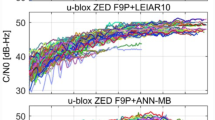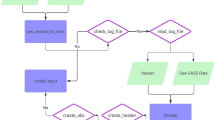Abstract
Precise point positioning (PPP) is famous for its capability of high-precision positioning and its wide application in many fields. With the rapid development of BDS and Galileo, the number of GNSS satellites used for positioning has now exceeded 110. It brings both opportunities and challenges to PPP. Based on the data of 90 tracking stations of MGEX, this paper analyzed the impact of elevation masks on the performance of multi-GNSS kinematic PPP. The results show that the PODP increases as the elevation mask increases. In general, it will reduce the positioning accuracy and the convergence speed with the increasing of the elevation mask for the PPP float solution. Furthermore, when the elevation mask is below 25o, increasing the elevation mask has little effect on the position accuracy of the horizontal and vertical components in the first 10 min. But after 15 min, the effect on the vertical component became apparently. And after convergence, the RMS of multi-GNSS PPP float solution can reach 5 cm and 10 cm for the horizontal and vertical components when the elevation mask is below 25o. When the elevation mask is 30o, the RMS is still less than 6 cm for the horizontal component, while about 99% of the RMS is less than 11.5 cm for the vertical component. Thirdly, for multi-GNSS PPP AR, it can improve the TTFF and the fixing percentage by fixing the ambiguity subnet with higher elevation mask firstly. Moreover, when the elevation mask is below to 20o, the improvement is more obvious and when the elevation mask is larger than 25o, the TTFF may become longer in some cases.






Similar content being viewed by others
References
An X, Meng X, Jiang W (2020) Multi-constellation GNSS precise point positioning with multi-frequency raw observations and dual-frequency observations of ionospheric-free linear combination[J]. Satellite Navigation. https://doi.org/10.1186/s43020-020-0009-x
Bisnath S, Gao Y (2008) Current State of Precise Point Positioning and Future Prospects and Limitations. In: Sideris MG (ed) Observing Our Changing Earth. Springer-Verlag, New York, pp 615–623
Böhm J, Niell A, Tregoning P, Schuh H(2006) Global map** function (GMF): A new empirical map** function based on numerical weather model data[J]. Geophys Res Lett 33(7). https://doi.org/10.1029/2005GL025546
Brack A, Günther C (2014) Generalized integer aperture estimation for partial GNSS ambiguity fixing[J]. J Geod 88(5):479–490
Cai C, Gao Y, Pan L, Zhu J (2015) Precise point positioning with quad-constellations: GPS, BeiDou, GLONASS and Galileo. Adv Space Res 56(1):133–143
Collins P, Lahaye F, Herous P, Bisnath S (2008) Precise point positioning with AR using the decoupled clock model. In: proceedings of the ION GNSS 2008, Savannah, 16–19 Sept, pp 1315–1322
Ge M, Gendt G, Rothacher M, Shi C, Liu J (2008) Resolution of GPS carrier phase ambiguities in precise point positioning (PPP) with daily observations. J Geod 82(7):389–399
Geng J, Shi C, Ge M, Dodson AH, Lou Y, Zhao Q, Liu J (2012) Improving the estimation of fractional-cycle biases for ambiguity resolution in precise point positioning. J Geod 86(8):579–589
Guo J, Li X, Li Z, Hu L, Yang G, Zhao C, Fairbairn D, Watson D, Ge M (2018) Multi-GNSS precise point positioning for precision agriculture. Precis Agric 19(5):895–911
Henkel P, Günther C (2012) Reliable integer ambiguity resolution: multi-frequency code carrier linear combinations and statistical a priori knowledge of attitude[J]. Navigation 59(1):61–75
Hu J, Zhang X, Li P, Ma F, Pan L (2020) Multi-GNSS fractional cycle bias products generation for GNSS ambiguity-fixed PPP at Wuhan University[J]. GPS Solutions 24:15. https://doi.org/10.1007/s10291-019-0929-9
Kouba J (2003) Measuring seismic waves induced by large earthquakes with GPS. Stud Geophys Geod 47(4):741–755
Laurichesse D, Mercier F, Berthias JP, Broca P, Cerri L (2009) Integer ambiguity resolution on undifferenced GPS phase measurements and its application to PPP and satellite precise orbit determination. Navigation 56(2):135–149
Leandro R, Santos M C, Langley R B (2006) UNB neutral atmosphere models: development and performance[C]//Proceedings of ION NTM. 52(1): 564–73
Li P, Zhang X (2014) Integrating GPS and GLONASS to accelerate convergence and initialization times of precise point positioning. GPS Solutions 18(3):461–471
Li X, Ge M, Zhang H, Wickert J (2013) A method for improving uncalibrated phase delay estimation and ambiguity-fixing in real-time precise point positioning. J Geod 87:405–416
Li X, Zhang X, Ren X, Fritsche M, Wickert J, Schuh H (2015) Precise positioning with current multi-constellation global navigation satellite systems: GPS, GLONASS, Galileo and BeiDou. Sci Rep 5:8328
Li X, Li X, Yuan Y, Zhang K, Zhang X, Wickert J (2018) Multi-GNSS phase delay estimation and PPP ambiguity resolution: GPS, BDS, GLONASS, Galileo. J Geod 92:579–608
Liu Y, Lou Y, Ye S, Zhang R, Song W, Zhang X, Li Q (2017) Assessment of PPP integer ambiguity resolution using GPS, GLONASS and BeiDou (IGSO,MEO) constellations. GPS Solutions 21(4):1647–1659
Lou Y, Zheng F, Gu S, Wang C, Guo H, Feng Y (2016) Multi-GNSS precise point positioning with raw single-frequency and dual-frequency measurement models. GPS Solutions 20(4):849–862
Montenbruck O, Steigenberger P, Prange L, Deng Z, Zhao Q, Perosanz F, Romero I, Noll C, Stürze A, Weber G, Schmid R, MacLeod K, Schaer S (2017) The multi-gnss experiment (mgex) of the international gnss service (igs)—achievements, prospects and challenges. Adv Space Res 59(7):1671–1697
Nadarajah N, Khodabandeh A, Wang KMC, Teunissen PJG (2018) Multi-GNSS PPP-RTK: from large- to small-scale networks. Sensors 18(4):1078
Parkins A (2011) Increasing GNSS RTK availability with a new single-epoch batch partial ambiguity resolution algorithm[J]. GPS Solutions 15(4):391–402
Rabbou MA, Elrabbany A (2017) Performance analysis of precise point positioning using multi-constellation GNSS: GPS, GLONASS, Galileo and BeiDou[J]. Surv Rev 49(352):39–50
Teunissen P (1995) The least-squares ambiguity decorrelation adjustment: a method for fast GPS integer ambiguity estimation. J Geod 70(1):65–82
Teunissen PJG (2007) Influence of ambiguity precision on the success rate of GNSS integer ambiguity bootstrap**[J]. J Geod 81(5):351–358
Teunissen P J G, Joosten P, Tiberius C C J M (1999) Geometry-free ambiguity success rates in case of partial fixing[J]. Proceedings of the National Technical Meeting of the Institute of Navigation :201–207
Wang J, Feng Y (2013) Reliability of partial ambiguity fixing with multiple GNSS constellations[J]. J Geod 87(1):1–14
Wu JT, Wu SC, Hajj GA, Bertiger WI (1993) Effects of Antenna Orientation on GPS Carrier Phase[J]. Manuscripta Geodaetica 18:91–98
Zumberge JF, Hefin MB, Jeferson DC, Watkins MM, Webb FH (1997) Precise point positioning for the efcient and robust analysis of GPS data from large networks. J Geophys Res Solid Earth 102(B3):5005–5017
Acknowledgments
The IGS is acknowledged for providing high-quality precise orbit and clock corrections as well as tracking data. The **amen **ang’an airport investment and Construction Co., Ltd. is acknowledged for providing tracking data.The **amen Key Laboratory of transportation infrastructure health and safety is acknowledged for providing project equipments.This work was partially supported by the National Natural Science Foundation of China (Grant No.41704033, Grant No.41704026), the **amen science and technology Program (Grant No.3502Z20193062) and the Natural Science Foundation of Jiangsu Province (Grant No.BK20191180).
Author information
Authors and Affiliations
Corresponding author
Additional information
Publisher’s note
Springer Nature remains neutral with regard to jurisdictional claims in published maps and institutional affiliations.
Rights and permissions
About this article
Cite this article
Wu, Y.b., Liu, Y., Yi, W. et al. Impact of elevation mask on multi-GNSS precise point positioning performance. Earth Sci Inform 14, 1111–1120 (2021). https://doi.org/10.1007/s12145-021-00619-0
Received:
Accepted:
Published:
Issue Date:
DOI: https://doi.org/10.1007/s12145-021-00619-0




